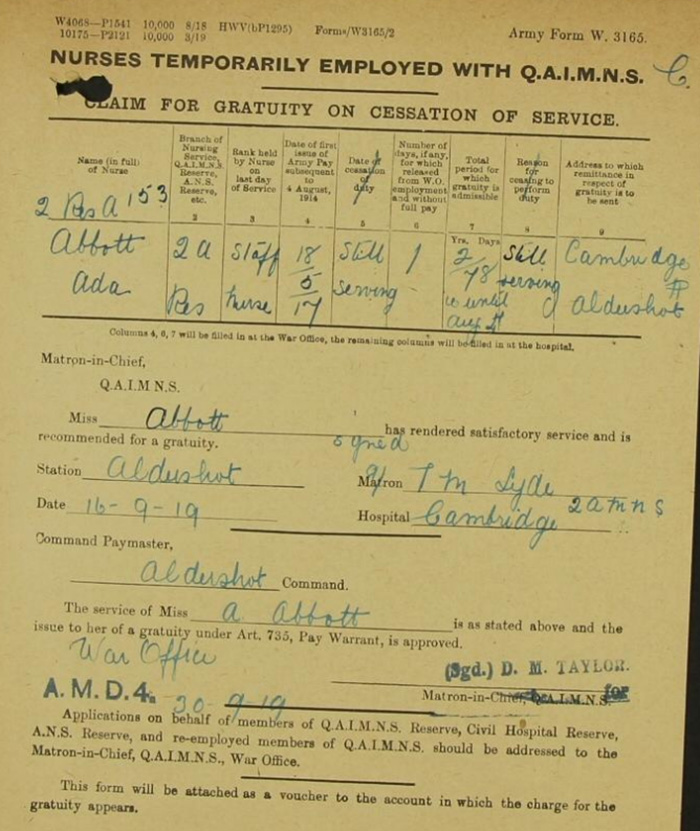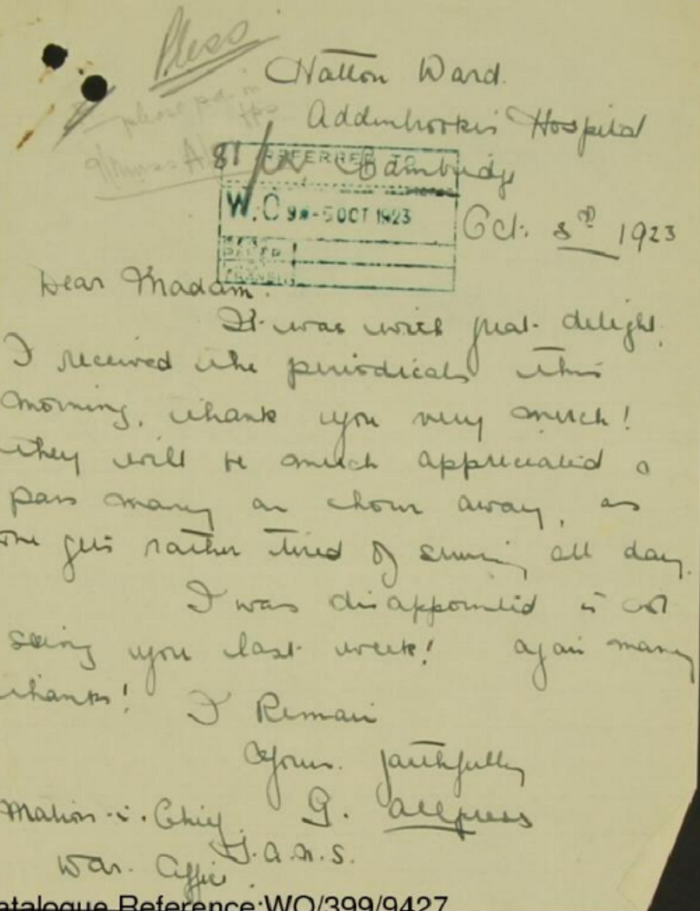Since late 2021, an increasingly large group of volunteers has been working its way through record series WO 399, which comprises records of women who served in the military nursing services during and after the First World War. These records are available to view through our digital download service through the catalogue, and as a result we have volunteers from across the world taking part.
At the moment, there isn’t very much detail about these files in the catalogue, but as a result of our volunteers’ hard work, we will be able to expand the catalogue description further in due course to include details like rank and the parent unit (for Territorial Force Nursing Service (TFNS) nurses), and confirm both married and maiden names as there does not appear to have been much consistency in whether the name was changed on a file after a nurse married, across the services. We’ll now be in a position to include both names, where applicable, which may make tracking down nurses who served under their maiden name but whose file is listed under their married names much easier!
We’re also going to be able to add actual dates of service to the catalogue description, as a combination of papers within the files allows us to determine this to the day for almost all the nurses in this series. For Queen Alexandra’s Imperial Military Nursing Service (QAIMNS) and QAIMNS Reserve nurses, most files include their enrolment forms, which give us a lot of detail. It’s unusual to find enrolment forms for TFNS nurses, but there are other details which allow us to work this out. Across the files, the appearance of an Army Form W 1365 or 1365(a) “Claim for a Gratuity on Cessation of Service” gives covering dates for a nurse’s mobilisation and demobilisation where she served in the First World War.

It’s been fascinating to spend so much time looking at these files, and this has given us a much better sense of the richness of these records. We know now, for example, that enrolment forms rarely survive in files belonging to nurses who served with the TFNS, but are almost always present in the files of QAIMNS nurses. On the other hand, confidential annual reports appear in virtually every TFNS file, but rarely appear in QAIMNS files. Correspondence within the files tells us that these reports were made for QAIMNS nurses but these seem to have been systematically weeded out. When the project began, it wasn’t clear that there were such clear differences between the records kept for the different units, but it is becoming apparent that the surviving files for the two main nursing services are distinct in terms of contents.
Both sets of records reveal a wealth of biographical and personal information. This project has also revealed the presence of Voluntary Aid Detachment nurses in the midst of the TFNS files, which was entirely unexpected. In due course, we’ll be comparing notes with the collections held at the British Red Cross archives to see what crossover there is too. We’ve also uncovered a number of files for women who served in the TFNS after the First World War, and the details of many women who served from the founding of these units before the war, sometimes up until the outbreak of war in 1939.
In addition to the facts and figures collected in the files, as we work through the files we are inevitably collecting a wide range of stories and anecdotes about the women who worked in the nursing services. Although some of these files are quite heavily weeded (and were so before they arrived at The National Archives), nonetheless it is possible to get a real sense of the women whose service they document. It’s also possible to trace relationships and friendships between women who worked in the nursing services.

Gertrude Allpress (WO 399/9427), for example, a staff nurse who was enrolled with the TFNS between 1916 and 1918, based in the 1st Eastern General Hospital at Trinity College, Cambridge, was very poorly with septicaemia before she was permanently invalided out of the service. Her file shows that the Matron-in-Chief, Dame Maud McCarthy, not only wrote to her during her convalescence to wish her a speedy recovery but also sent her a parcel of magazines to read at her leisure. This rather remarkable gesture of kindness, from the most senior nurse in the service to one of the most junior, was a really lovely find.
There is still capacity for the project to take on some more volunteers, so if you are interested or know someone who might be, please encourage them to take a look at the project page here, and get in touch.
We are fortunate to have an excellent database of records for Canadian nurses who served overseas in WWI at Library and Archives Canada. Since many were attached to UK hospitals this extra information will be valuable. There’s very little information about military nurses who remained in Canada so this project will also give us a broader perspective.
i would love to volunteer on the military nurses project, please. I used to be a friend of the national archives. I am a member of the kew society. I look forward to hearing from you in due course with great interest. Thanking you in advance for your assistance in this matter. Yours ever rosalind graham hut post grad dip chaplaincy surrey 2003-06 Day Chaplain southwark cathedral anglican semi-retired aged 55.
What about British women who served as nurses in WW1 under the auspices of the French Red Cross? Are there any records and plans to catalogue these ladies? My grandmother was one such nurse and latterly went on to be a Matron after the war. She was Scottish and one brother, an officer, died with others of his Company on the Somme in 1916 whilst her other brother was a doctor with the Medical Corps at Gallipoli and elsewhere. (What I mean to say is that there was no pre-existing French connection and presumably there would have been lots of British nurses in the same situation i.e., presumably not signed up with QAIMNS, etc.)
Hi Gregor. These records are in the care of the archive of the International Red Cross and you can find out more information about them here: http://www.redcross.org.uk/about-us/our-history/first-world-war-volunteers.
I’ve looked at some of these nurses records before but this project enables you to focus on a structure and a process to enable a more logical exploration, maybe even analysis, of their lives. You often find little snippets that add colour, both to the nurses lives and to their seniors. It’s a very satisfying project to be involved with and quite a privilege.
The blog actually puts it all into perspective.
I have copies of pages from an autograph book owned by Edith Kate Matthews’ niece (I think). She worked at Lewisham Military Hospital and the autographs (plus drawings, verse etc.) were made by staff and patients. Many of the patients were Australians who had been wounded at Gallipoli. When I lived in Australia, I visited the Australian War Memorial in Canberra and was able to research the Aussies. However, for most of the British patients – and the staff – records are very patchy. I would be happy to share what I have and would appreciate help.
Having finished remote digitizing on “crew list ” I am looking to start a new remote project.
Would you put me in touch with any available project.
Regards
We have a photo album from WW1 with photos of a soldier in Egpyt and a nurse Betty Sheriden. The photos of Betty are taken at: No 1 Stationary Hospital France after the Battle of Neuve Choppelle, 4th Gen Hosp Feb 1915 France, Indian Camp Hosp in Rowen and Convelesant Encampment, York Minister from Betty’s bedroom, Loos York Hospital with soldiers with limbs missing plus one of Betty’s VAD nurses Lady Joan Shirley and a Padre.
Who is Betty, she appears to be a QAIMNS? Is she from New Zealand as the soldier in the album is? Any help would be wonderful, thank you.